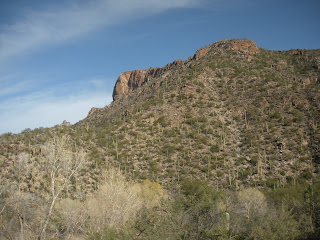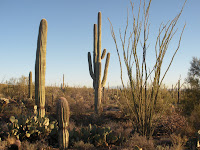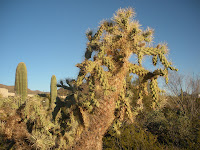The Saguaro National Park is split into two areas, one on the east side of Tucson, and one on the west side, together totalling nearly 100,000 acres. The park sets aside a part of the Sonoran Desert with much of it officially designated as Wilderness Area.
The Park is named after the Saguaro cactus, a variety native to this area, sometimes called the "Sentinel of the Desert". Legend of the Native Indians holds that when you die, your soul becomes a Saguaro . . . and that if you stand silently in the desert, the Saguaros begin to look like people, maybe even some of your ancestors. The Saguaro is, indeed, a fascinating plant.
The Native Indians harvest the fruit of the Saguaro and make jelly, jam, and syrup. It is illegal to sell commercially products made from the Saguaro Cactus. These products can, however, be sold on the Indian Reservation, but they are so labor-intensive that the Indians make very little for sale, but instead consume most of it themselves. What little they do sell is extremely expensive.
Although the park is named for the Saguaro, many other species of cacti also grow in the park, including the barrel, cholla, and prickly pear.
It is the Saguaro, however, that I find most fascinating.


These "desert trees" can take 75 years to develop the first "side arm" and some plants live to be 150-200 years old. Roots of the Saguaro only grow about 3"-6' deep, but spread out well beyond the arms, as far as the plant is tall. Fine hair-like roots can suck up as much as 200 gallons of water during an infrequent desert rain . . . enough water to last the plant for up to a year. Following a rain, the size of a Saguaro trunk is visibly larger after it has absorbed all of that rain water and expanded like an accordion. Its waxy skin minimizes loss of water by evaporation.
Many places in the park are literally "Saguaro Forests".
Although the tallest Saguaro I saw was about 30 feet tall, a Saguaro cactus can grow to 50 feet tall.
The cactus in the above self portrait was 25'-30' tall. The immensity of these "Sentinels of the Desert" is overwhelming. One of the wonders of this marvelous planet Earth . . . God's handiwork.






























